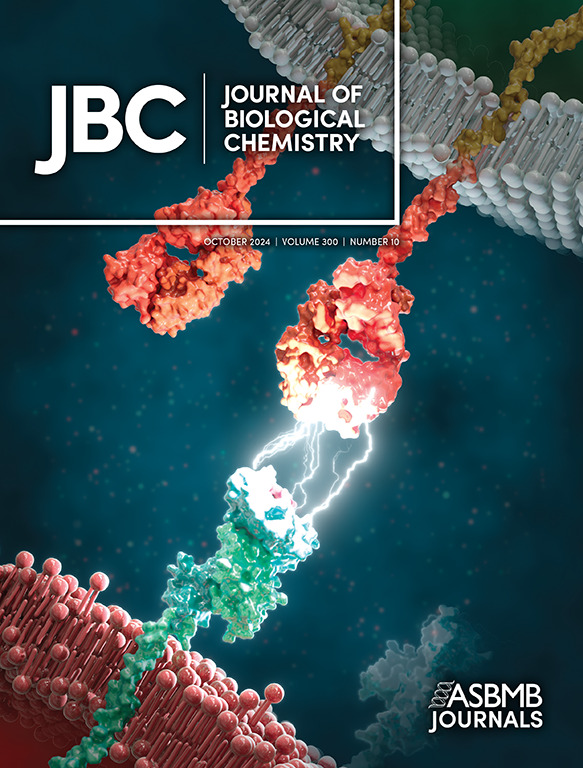CH−π Interactions Confer Orientational Flexibility in Protein–Carbohydrate Binding Sites
IF 4
2区 生物学
Q2 BIOCHEMISTRY & MOLECULAR BIOLOGY
引用次数: 0
Abstract
Protein−carbohydrate binding plays an essential role in biological processes including cellular recognition and immune signaling. However, glycans are hydrophilic with limited hydrophobic surfaces, a challenge for selective recognition by proteins. CH–π stacking interactions are pervasive in protein-carbohydrate binding sites and have emerged as critical drivers of protein–carbohydrate recognition. They are highly favorable and have a broad orientational landscape. However, it is unknown how CH−π stacking interaction orientational dynamics are influenced by the protein environment and what their functional interplay is with hydrogen bonds in protein–carbohydrate binding. Here, we employ well-tempered metadynamics simulations to obtain binding free energy landscapes for a set of protein−β-D-galactoside complexes with CH–π stacking interactions. Our data show that the favored orientation of a CH−π stacking interaction is controlled by the location of hydrogen bonds in the protein binding site. Complexes with extended carbohydrate ligands that form additional hydrogen bonds have more specific orientational dependences, while protein variant complexes with fewer hydrogen bonds have broader free energy landscapes with glycan ligands adopting multiple CH−π stacking interaction orientations. We also show that forming multiple CH−π stacking interactions facilitates the dynamics necessary for the translocation of oligosaccharide ligands within a processive enzyme. Our findings underscore the cooperative nature of hydrogen bonds and CH−π stacking interactions, demonstrating that tuning the number and positions of these interactions through evolution or protein engineering can alter ligand recognition or support ligand movement in protein binding sites.CH−π相互作用赋予蛋白质-碳水化合物结合位点的取向灵活性
蛋白质-碳水化合物结合在包括细胞识别和免疫信号在内的生物过程中起着至关重要的作用。然而,聚糖具有有限的疏水表面的亲水性,这对蛋白质的选择性识别是一个挑战。CH -π堆叠相互作用普遍存在于蛋白质-碳水化合物结合位点,并已成为蛋白质-碳水化合物识别的关键驱动因素。它们非常有利,有广阔的方位景观。然而,目前尚不清楚CH−π堆叠相互作用的取向动力学如何受到蛋白质环境的影响,以及它们在蛋白质-碳水化合物结合中与氢键的功能相互作用。在这里,我们采用了良好调节的元动力学模拟来获得一组具有CH -π堆叠相互作用的蛋白质- β- d -半乳糖苷配合物的结合自由能景观。我们的数据表明,CH−π堆叠相互作用的有利方向是由蛋白质结合位点上氢键的位置控制的。具有扩展碳水化合物配体形成额外氢键的配合物具有更特定的取向依赖性,而具有较少氢键的蛋白质变体配合物具有更广泛的自由能景观,与采用多个CH−π堆叠相互作用取向的聚糖配体。我们还表明,形成多个CH−π堆叠相互作用促进了过程酶内低聚糖配体易位所需的动力学。我们的研究结果强调了氢键和CH−π堆叠相互作用的合作性质,表明通过进化或蛋白质工程调整这些相互作用的数量和位置可以改变配体识别或支持配体在蛋白质结合位点的运动。
本文章由计算机程序翻译,如有差异,请以英文原文为准。
求助全文
约1分钟内获得全文
求助全文
来源期刊

Journal of Biological Chemistry
Biochemistry, Genetics and Molecular Biology-Biochemistry
自引率
4.20%
发文量
1233
期刊介绍:
The Journal of Biological Chemistry welcomes high-quality science that seeks to elucidate the molecular and cellular basis of biological processes. Papers published in JBC can therefore fall under the umbrellas of not only biological chemistry, chemical biology, or biochemistry, but also allied disciplines such as biophysics, systems biology, RNA biology, immunology, microbiology, neurobiology, epigenetics, computational biology, ’omics, and many more. The outcome of our focus on papers that contribute novel and important mechanistic insights, rather than on a particular topic area, is that JBC is truly a melting pot for scientists across disciplines. In addition, JBC welcomes papers that describe methods that will help scientists push their biochemical inquiries forward and resources that will be of use to the research community.
 求助内容:
求助内容: 应助结果提醒方式:
应助结果提醒方式:


